Honeywell Gent
Honeywell Gent (also Gent by Honeywell) is a subsidiary of Honeywell and a notification equipment supplier headquartered in Leicester, LEC. For over a century, Gent was a well-known manufacturer of electrical equipment, in particular its electric clocks, which were used in public buildings and railway stations all over the world. Gent was one of many companies that was commissioned by the British government to produce sirens during World War II to warn of incoming air raids on British cities by Nazi aircraft. After a series of takeovers, Gent eventually came under the ownership of Honeywell, and the company's primary focus has been fire detection and alarm systems since its acquisition.
History
Honeywell Gent, originally John T. Gent & Co., was established by John Thomas Gent sometime in 1872, but could've been trading as early as the 1860s. The company manufactured various of signals during its early years, including electric and pneumatic bells, as well as "products intended for the generation and storage of electricity". By the late 1930s, The company, now trading as Gents' of Leicester, sold bells, clocks, power supplies, fire alarm systems, telephones and signaling and recording equipment. Following the outbreak of World War II in 1939, the British government commissioned Gents' to produce sirens to warn of incoming air raids on British cities by Nazi aircraft. Gents' developed the 'Tangent' line, a variety of dual rotor electric sirens (also referred to as "syrens" by the company), competing with the likes of Carter and Castle Castings.
Originally, Gents' was the only manufacturer that was legally allowed to create air raid sirens due to an administration error, before this was later corrected. Gents' made several innovations with their 'Tangent' sirens, including conical-shaped rotors and stators and sirens with 3 different ports, creating a tri-tone. Gents' also sold equipment for aircraft and radar communications during the war. Their siren venture continued well past the end of World War II as the business continued to grow; Gents' of Leicester continued to build electric clocks among other notification equipment such as the popular "Warbler" series of fire alarm sounders, until 1975, when the company was taken over by the international organization Chloride. Subsequently, Gents was renamed Gent of Leicester, and then Chloride Gent. Following the takeover, many of Gents' products were discontinued. This included their long running Tangent series, sans the Model 1500 'Strident', a tiny industrial siren which would later be stripped of the 'Strident' name following the rename to Chloride Gent.
In July of 1983, the company was again sold from Chloride to the MK Electric Group, becoming 'Gent Limited', with a few of Gent's older factories being shut down during this period. By this time, the Model 1500, Gent's last still-produced siren, was discontinued; no units are known to have Gent Limited branding. Nevertheless, Gent moved on, with new fire alarm sounders and an array of new products being developed in the 1980s and early 1990s. Gent was once again bought in 1993, this time by the Caradon/Novar company. Finally, in 2005, the company was acquired by Honeywell and has been known as 'Gent by Honeywell' ever since, though more recently has been branded as 'Honeywell Gent'. The company is legally known as Novar Systems Ltd. Still based in Leicester, the company is now mostly involved with fire detection and alarm systems.
Products
Tangent
Tangent was a line of dual rotor electric sirens (also referred to as "syrens" by the company, as this was the common spelling for British sirens during WWII) that were produced by Gents' of Leicester during World War II, competing with the likes of Carter and Castle Castings to warn of Axis air raids in Britain. These sirens would see limited service after the war for various other purposes.
Type 1461
Type 1461 was the only electric vehicular siren produced by Gents. It consists of the 8-inch 15-port rotor and stator from the Type 1479, driven by a 12 V DC ¹⁄₁₅ hp electric motor. The siren had only 8 amps of continuous amperage draw, which made it suitable for emergency vehicles of its day. It was primarily designed to replace tire and flywheel-driven friction sirens in use at the time, as they were found to be both unreliable and potentially dangerous. The siren has no projector or motor cover and sits on a small inverted U-shaped mount. An ornate cover protects the siren's intake from debris or user error.
Type 1468
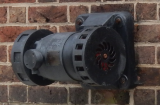
The smallest dual rotor siren made by Gents', Type 1468 is a small step up from the Type 1479. The Type 1468 makes use of 8-port and 15-port rotors and stators and were available in 8/8-port or 15/15-port single tone, and 8/15-port dual tone. The siren is driven by a ¼ hp AC motor running at 50 Hz, likely on 1 ph power. Little else is known about this siren, but at least two dual-tone units remain.
Type 1469
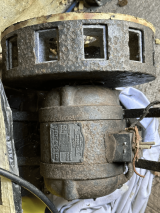
Type 1469 (sometimes marked as Type IND on the tag) is a single rotor siren that was produced by Gents'. The Type 1469 makes use of a single 12-port rotor and stator attached to one side of a ½ hp AC induction motor, running at 50 Hz on 220 V 1 ph power. The siren's rotor is likely very similar to the 12-port side of the Type 1471 and is likely a single-rotor variant of that siren. The Type 1469 is a horizontally mounted siren, with a large square base acting as a mount, with four screw holes. The motor is attached to the base by two thin strips of metal. The siren could come with a manual shutter, which swivels over the intake to block the intake of air and make the siren much quieter if desired. The Type 1469 is an extremely rare siren, with very few units known to still exist today. It has a distinctively thinner rotor and stator compared to many British sirens of the time, including Gents' other models.
Type 1471
The smallest dual-tone siren in the Tangent lineup, Type 1471 is a dual-tone electric siren that makes use of two rotors and stators on either side of a 1 hp AC motor, running at 50 Hz, 1 or 3 ph. The Type 1471 has a 10-port rotor on one side, and a 15-port rotor on the other, making the siren 10/15-port dual tone. The siren's bare motor is attached to a small, square stand for mounting purposes. The 1471 is considered extinct, as no surviving units are known to exist.
Type 1472
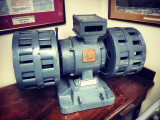
Type 1472 is a unique quad-rotor siren that was produced by Gents'. The siren resembles a regular dual-tone siren but with two additional rotors and stators driven by one rotor shaft. The siren is unique in that it is a tri-tone siren, with three different ports. The two middle rotors and stators are 10-port, while a 12-port rotor/stator is attached on one side, and a 15-port rotor/stator is attached on the other. This results in a 12/10/10/15 tri-port siren, which has a distinctive, nearly musical sound. The siren originally had a 12/10/15/10 port configuration before 1936. The siren is driven by a bare dual-sided 2 hp AC motor, running at 50 Hz in either 1 or 3 ph. The siren resembles a dual rotor siren as each rotor and stator are thin enough to not require additional outer bearings. The siren includes a square-shaped stand below the siren for mounting purposes, which originally spanned the entire width of the siren, at least for 1 ph units. 1 ph units use an asymmetrical motor. A few of these sirens survive today in private possession and museums, with at least one in functional condition.
Type 1474
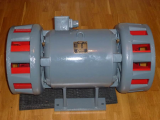
Type 1474 (sometimes marked as Type ARP on the tag) is a medium-sized dual rotor siren that is one of the most well-known Gents' sirens and closely resembles Carter and Castle Castings sirens in both appearance and sound. The Type 1474 was available in 10/12-port dual tone only as standard, driven by a dual-sided 4 hp AC motor running at 50 Hz, 1 or 3 ph. The Type 1474 is unique and distinctive in appearance, using conical-shaped stators. If this wasn't a purely stylistic choice, it was possibly an attempt to direct some of the sound towards the intakes. The Type 1474 was available with optional coding dampers similar to those used by the Klaxon CS8 and Federal Signal 3T22, which would allow it to create a pulse or hi-lo signal. These dampers would be included with extended, pointed intakes, and the solenoid mechanism was located underneath each intake. The stators are attached to the motor by four legs, with the rotor shaft in the middle. This is a similar configuration to the Sterling Model M. The siren has a rounded motor cover which shields the motor from the elements, and the siren includes a simple four-legged stand for mounting. The Type 1474 was the most successful model, and at least one remains in service today as an industrial fire alarm.
Type 1478
Type 1478 is one of the most peculiar and unique sirens that was sold by Gents'. This siren uses a layout somewhat similar to that of Dillon Box's Denver sirens or Yamaha's Music Sirens, utilizing 4 separate rotors and stators, all connected to a single, long shaft coupled to the motor. The two inner rotors and stators are 12-port, while the two outer rotors and stators are 10-port. The Type 1478 uses the same rotors and stators as the Type 1474 and can be seen as a larger variant of one. The siren's dual-sided motor is located in the center and is 8 hp, running on 50 Hz AC, 1 or 3 ph. Due to the additional weight of the extra rotors/stators, the Type 1478 includes two additional bearings between each set of rotors/stators, held up by solid supports that also hold the stators. The motor and bearings are attached to a single long common frame, which makes the siren impossible to mount on a singular pole. Two eyebolts are attached to lift the siren onto a rooftop by a crane. Understandably, the Type 1478 was not very successful due to its large size and expense, and very few are known to exist today, none in working order.
Type 1479
Type 1479 is the smallest siren in the Tangent lineup, being little more than an indoor industrial siren repurposed as an outdoor air raid siren. Intended to fill small coverage gaps, the Type 1479 is a single-rotor electric siren that uses an 8-inch 15-port rotor and stator, driven by a ⅒ hp AC motor at 50 Hz, up to 250 V AC. The Type 1479 is extremely simple in design, with the rotor and stator attached to one side of the motor. The motor itself is protected by a rounded motor cover, and a small stand is located below. Unlike all other Gents' sirens, the Type 1479 uses curved vanes on the rotor (similar to a B&M or Federal Q-Siren), which offers much better efficiency for the rotor's size.
Type 1480
Type 1480 is a coded electric siren that was sold by Gents'. It was very similar to the Denver Duplex. The siren has an either a 10 or 12-port rotor and stator, driven by an exposed motor and connected to a brake mechanism which would allow the siren to quickly stop at a fast pace. Not much is known about these sirens, except their appearance and one location, which was located on the Fifth of Forth rivers until its eventual removal.
Type 1481
Type 1481 is a coded electric siren that was sold by Gents'. It seems to be based on the design of the Type 1480 and Type 1478, instead utilizing 4 rotors and stators similar to the Type 1478, albeit with a 12/12/12/12 port single-tone configuration. The siren is driven by an exposed motor and connected to a brake mechanism which would stop the siren at a fast pace. No known examples exist to this day nor are any previous locations known as of now.
Model 1500
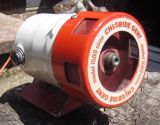
Model 1500, or The Strident, is an indoor fire siren that was produced by Gent of Leicester (later Chloride Gent) from sometime preceding 1975 to 1983 at the very latest. It was the last siren branded under the Gent name after the Tangent sirens ceased production. The Model 1500 utilizes a small 4 or 6-port rotor and stator and is driven by a small 200 V AC or 250 V DC motor encased in a cylindrical housing. A small, circular disk with the company logo, voltage, and name engraved on it is attached to the front of the stator via 4 bolts. The siren has a small stand with supports on the bottom of the stator as well as one on the bottom of the motor cover. The motor's brushes stick out of the housing on both sides, near the tail end of the motor cover. After Gent was renamed to Chloride Gent, the "Strident" name would be dropped and the disk would be altered, now reading "CHLORIDE GENT model 1500 siren" and the top right and bottom left. The siren would likely be produced until the early 2010s when it would be replaced by Honeywell Gent's electronic fire alarm offerings. Today, a handful of units still exist, with most being in the hands of collectors.
Gallery
Tangent
-
Type 1461 as advertised.
-
Type 1471 as advertised.
-
Type 1478 as advertised.
-
Type 1478 as advertised.
-
Type 1480 as advertised.
-
Type 1481 as advertised.






